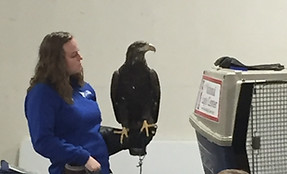
Wildhaven


Nestled along the East Fork of the Des Moines River in Algona, Iowa is an area of trees, grass, ponds and wildlife that is rarely seen by most area residents.
"Wildhaven" is owned by the Donald Tietz Charitable Foundation, and contains over 100 acres of land. Wildhaven has access to the East Fork of the Des Moines River, beautiful ponds and other natural resources, providing a perfect spot for area students to explore and learn about nature. Both Algona High School and Bishop Garrigan High School science classes are given unrestricted access to the campus for educational purposes.
The property, which was a farm and an abandoned gravel pit, was purchased by Don Tietz in the mid-1960s. Two of Don’s cousins with backgrounds in natural resources management, Craig Lauritson and DuWayne Gebken, helped solidify this mission. Craig developed a fish management plan for Golden Pond. DuWayne prepared a comprehensive geographic information system management plan for the Wildhaven Campus.
Wildhaven is a wildlife preserve that attracts many species of birds and nearly every mammal in Iowa. The trails are designed to showcase the beauty of nature and how it changes with the seasons in Northern Iowa. This area is truly a gem for a region so rich in agriculture.
Donald Tietz Wildhaven Educational Fund
A fund has been set up to ensure educational opportunities continue to inspire our local students. Your gift to the Donald Tietz Wildhaven Educational Fund will provide support to the science departments at Algona High School and Bishop Garrigan High School. Both schools work together to develop programs for students that expand the schools' existing natural science programs.
Click here to donate to the Donald Tietz Wildhaven Educational Fund
Inside a Student's Field Trip to Wildhaven
Area sophomores pay a visit to Wildhaven each year with their science class. Teachers Beanie Bode (Bishop Garrigan) and Steve Young (Algona High School) look forward to this day of learning, and the impact it makes on their students. The field trip is broken down into stations where experts teach about various topics. The students are served lunch and spend the day enjoying the wildlife and our environment.

Testimonials from students based on the various stations:
Student
Testimonial
STATION:
Chronic Wasting Disease
Instructor:
TJ Herrick,
Iowa DNR
"I really enjoyed this station about Chronic Wasting Disease, what it is, how they test for it, the reasons why it is around and how it could affect us. Chronic Wasting Disease is a disease that wastes away the brain of deer. In the demonstration it was really cool to learn how they test deer for this type of disease by testing the lymph nodes. If the results are positive, they tell the person who owns the deer to not eat it. They are told to kill off as many deer as they can around their area to keep that disease from spreading. This disease had grown among many deer who are in the same pen, causing it to spread quickly. They aren’t sure if this disease will affect humans but they don’t want to take that chance of having it spread like Cow Disease did in England."
Student
Testimonial
STATION:
Iowa Fire Ecology
Instructor:
Brody Bertram
"I enjoyed the station about Iowa Fire Ecology and learning about the tools we use. It was interesting to see how much work goes into burning a prairie, why our soil is so rich and why it is important. There were so many steps that Brody had to do before he even set fire to the prairie. First we had to check the weather, temperature, humidity the mixing height, the wind speed and direction, and so much more. Brody had special equipment he had to wear and use. He wore leather boots, fire resistant pants, shirt, mask and finally a helmet. All these things were to protect him from the fire. Next he had many tools such as a rake, a drip can, and a rubber tool that put the fire out. It was an awesome experience to see how much preparation and time went into this to maintain and protect our prairies."
Student
Testimonial
STATION:
Orinthology
Instructors: Billie Wille and Julie Fosado
"I really enjoyed this session learning about birds, how to look for them and how to identify them. Ornithology is the study of birds. I enjoyed how Billie showed us how to use binoculars properly, by first looking at the bird and then putting the binoculars up to your eyes. Another way to find birds without looking is by staying quiet and listening to see if you can hear them. To identify a bird you look at the markings of its belly, eyes, talons, beak and other characteristics. We looked at a Pelican's beak and noticed a bump. The bump forms in the spring, telling other Pelicans that it was old enough to mate. When it didn’t have that bump it meant it was either too young or too old. It was a very nice way to learn more about birds and I really thought it was a peaceful time."






